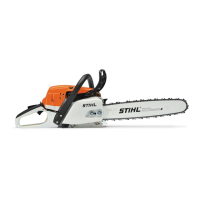MS 261, MS 261 C
English
17
Cutting Techniques
Felling
Felling is cutting down a tree.
Before felling a tree, consider carefully
all conditions which may affect the
direction of fall.
Felling Instructions
When felling, maintain a distance of at
least 2 1/2 tree lengths from the nearest
person.
When felling in the vicinity of roads,
railways and power lines, etc., take extra
precautions. Inform the police, utility
company or railway authority before
beginning to cut.
Escape Path
First clear the tree base and work area
from interfering limbs and brush and
clean its lower portion with an ax.
Then, establish two paths of escape (B)
and remove all obstacles. These paths
should be generally opposite to the
planned direction of the fall of the tree
(A) and about at a 45° angle. Place all
tools and equipment a safe distance
away from the tree, but not on the
escape paths.
Warning!
There are a number of factors that may
affect and change the intended direction
of fall, e.g. wind direction and speed,
lean of tree, surrounding trees and
obstacles, sloping ground, one-sided
limb structure, wood structure, decay,
snow load, etc. To reduce the risk of
severe or fatal injury to yourself or oth-
ers, look for these conditions prior to
beginning the cut, and be alert for a
change in direction while the tree is
falling.
Warning!
Always observe the general condition of
the tree. Inexperienced users should
never attempt to cut trees that are
decayed or rotted inside or that are
leaning or otherwise under tension.
There is an increased risk that such
trees could snap or split while being cut
and cause serious or fatal injury to the
operator or bystanders. Also look for
broken or dead branches which could
vibrate loose and fall on the operator.
When felling on a slope, the operator
should stand on the uphill side if
possible.
Warning!
The noise of your engine may drown
any warning call.

